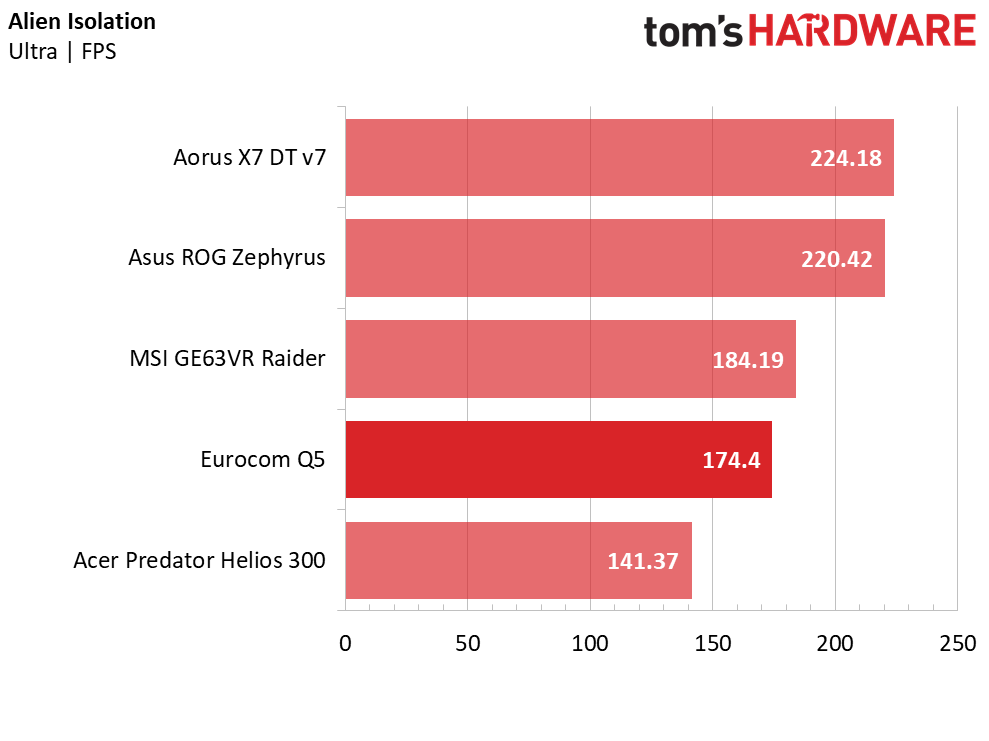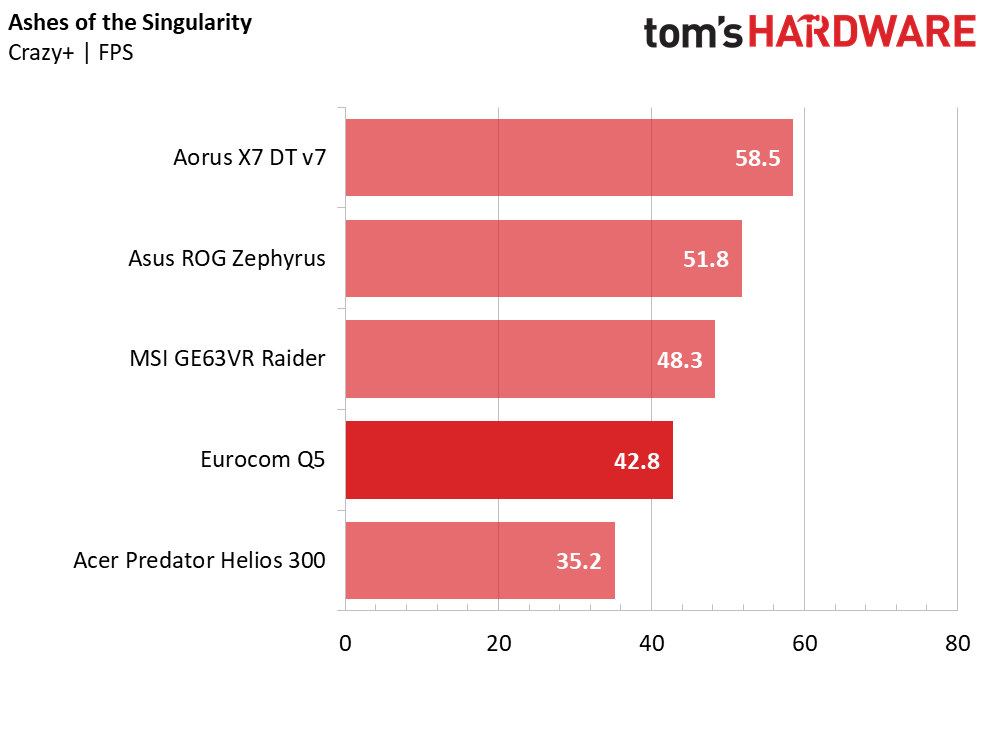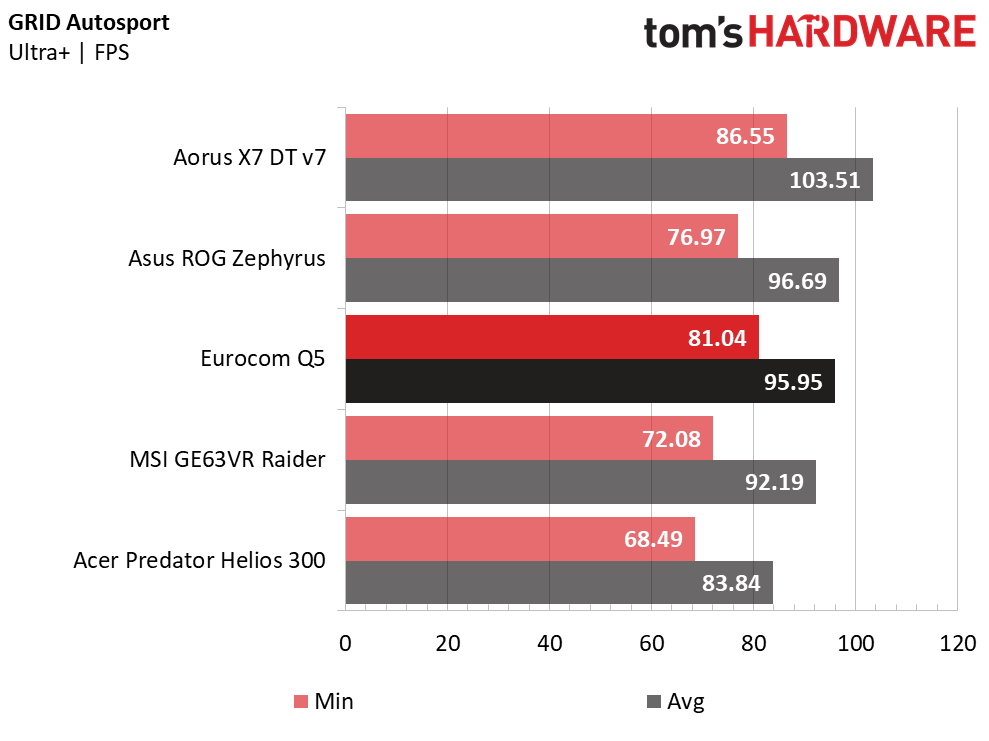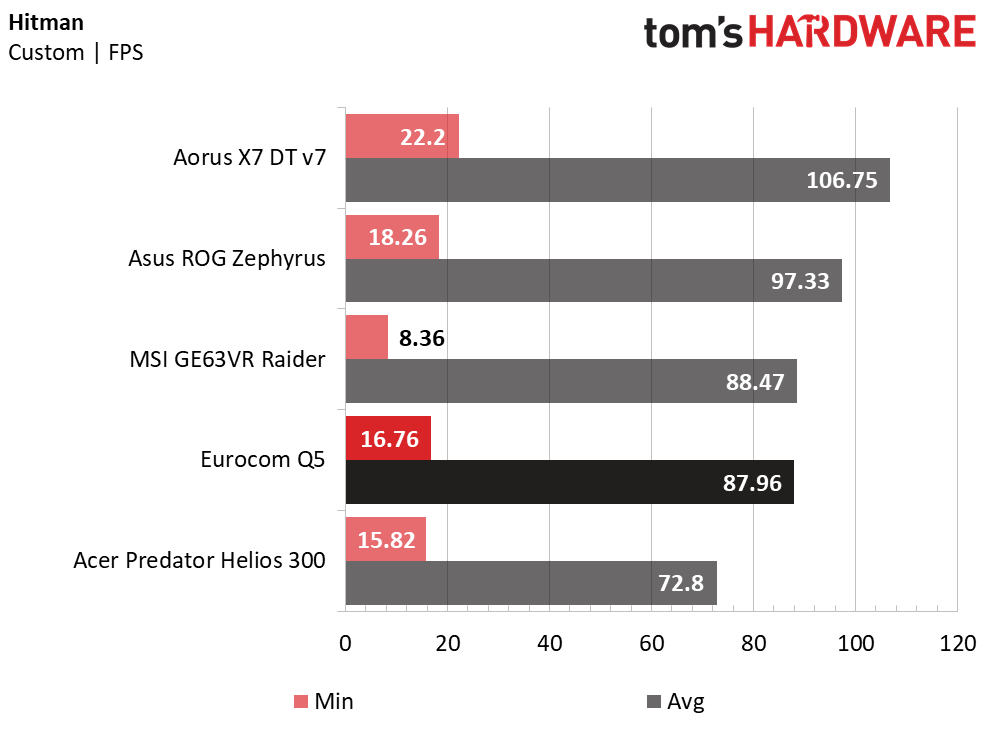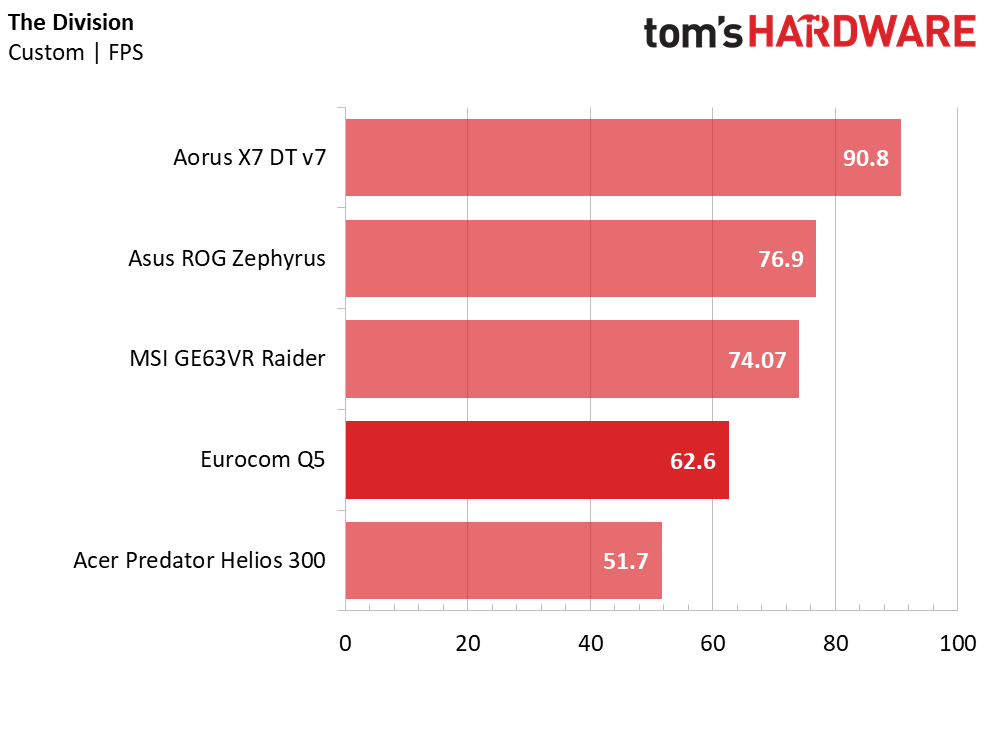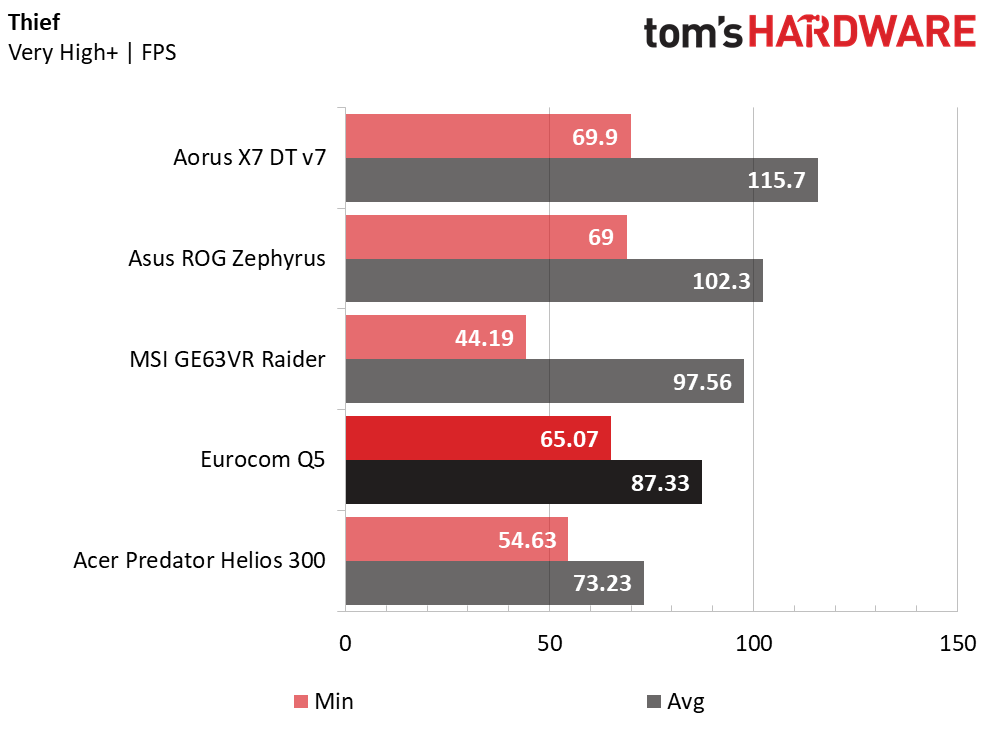Eurocom Q5 Max-Q Gaming Laptop Review
Why you can trust Tom's Hardware
Gaming Benchmarks
Alien: Isolation
Alien: Isolation is our first gaming benchmark, and the Eurocom Q5 sits where we'd expect it to. However, our 3DMark results appear to misrepresent the GTX 1070 Max-Q’s actual gaming performance, at least in this title. Rather than a perfect staircase in our charts, the Q5 keeps up with the MSI GE63VR Raider’s GTX 1070 admirably, performing only about 6% slower and outperforming the Predator Helios by nearly 20%.
Ashes of the Singularity
Ashes of the Singularity is much more demanding than Alien: Isolation, and our charts illustrate the staircase effect once again. The culprit is the Eurocom GPU’s thermal throttling. We measured the GTX 1070 Max-Q’s average temperature (74°C) and boost clock rate (1377 MHz) during this benchmark, and even though it's running at near maximum efficiency, it still doesn’t deliver as much performance as the MSI Raider.
Note: A typical GTX 1070 boost clock rate is 1645 MHz; Max-Q specifications tout 1379 MHz as the boost clock rate.
As a result, the Q5’s frame rate falls around 13% below that of the MSI Raider, bringing it well under 50 FPS. You’ll have to make substantial graphical setting compromises to bring the frame rate back up to a smooth 60 FPS. Fortunately, the GTX 1070 Max-Q still outperforms the GTX 1060 by about 18%.
DiRT Rally
We looked at some of the GPU data during our DiRT Rally benchmark again, and we saw the Eurocom Max-Q GTX 1070 temps at around 74°C with a boost clock of 1382 MHz, which is slightly higher than Nvidia’s 1379 MHz rating. Despite this, the Eurocom Q5 underperforms the MSI Raider laptop by nearly 17%, or 11 FPS.
Fortunately for the Q5, the performance degradation doesn’t pull the frame rate below 60 FPS. The GTX 1060 drags down the Predator Helios, which runs nearly 20% slower than the Q5, or around 13 FPS.
Grand Theft Auto V

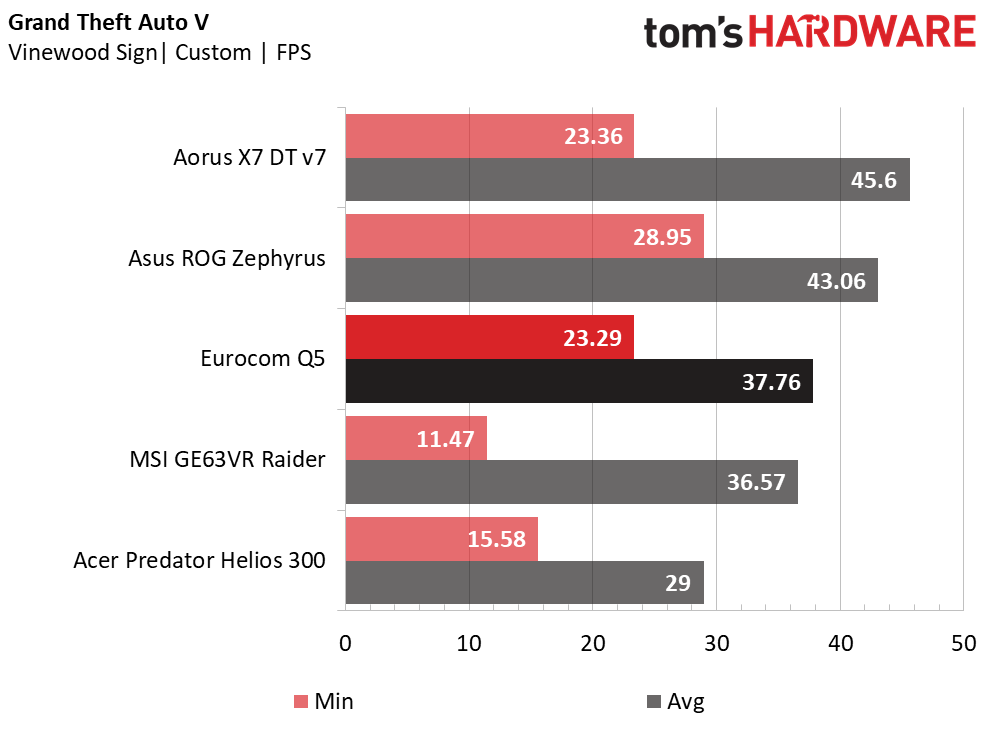
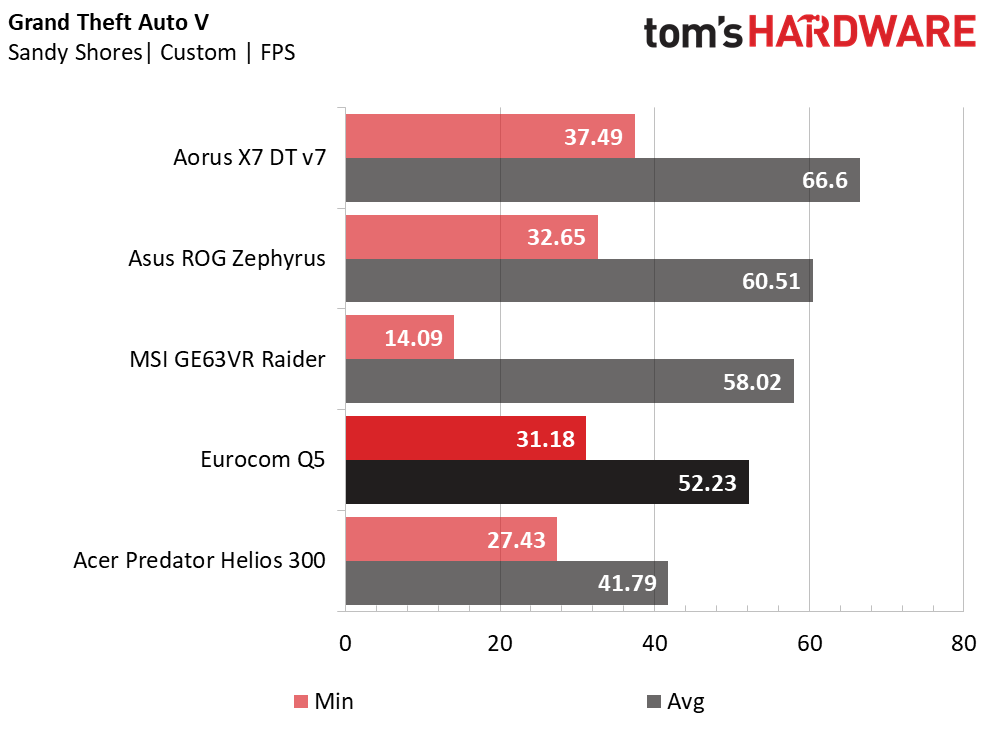
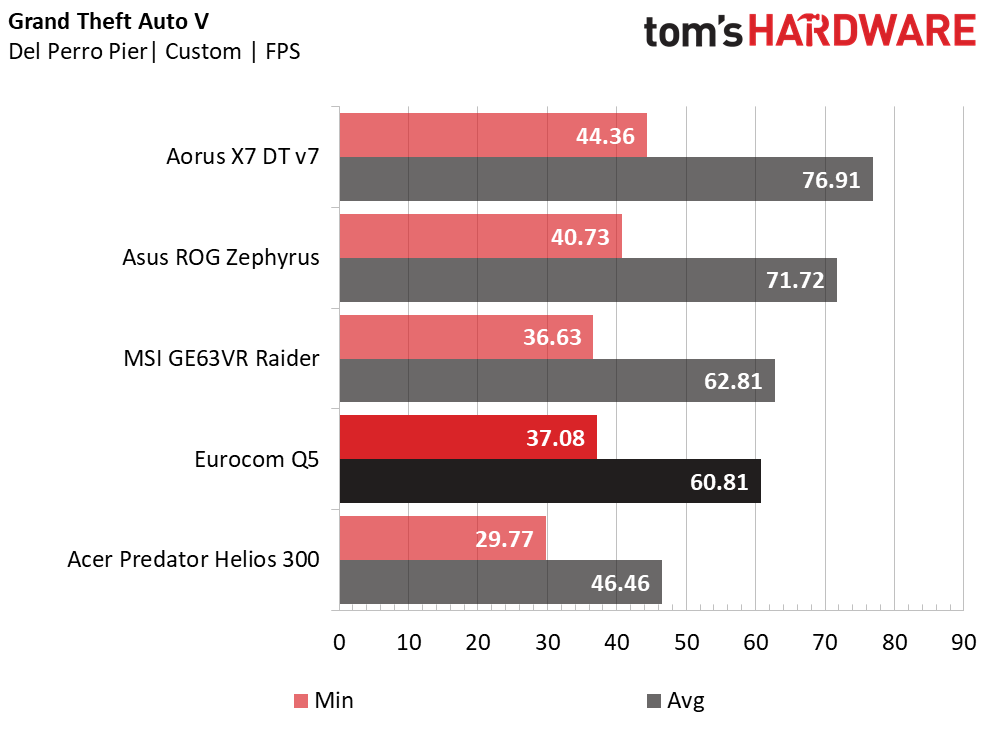
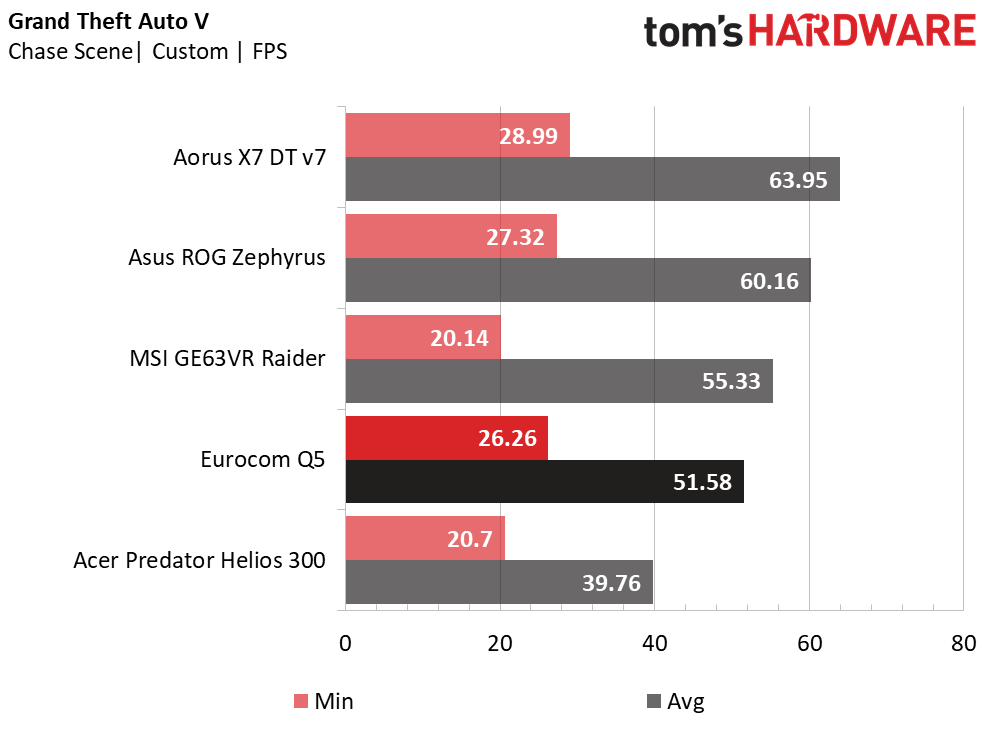
Grand Theft Auto V is one of the most demanding games in our suite, so you would expect a Max-Q 1070 GPU with a lower maximum boost clock than a regular mobile 1070 GPU to perform much slower. Although the GTX 1070 Max-Q exhibits an average temperature of 71°C for the duration of the benchmark, and an average boost clock of 1359 MHz, well under Nvidia’s max boost clock rating, frame rate-wise, the Q5 keeps up with the MSI Raider on nearly all accounts, and even exceeds the latter during the infamous Vinewood Sign scene. We no longer have the MSI Raider at our disposal to examine if it was similarly throttled due to thermal limitations, but this would seem a logical explanation.
Get Tom's Hardware's best news and in-depth reviews, straight to your inbox.
However, the GTX 1070, Max-Q or otherwise, still doesn’t deliver an ideal 60 FPS average. Only a GTX 1080 is capable of doing so, and you’ll need at least the X7 (or the Zephyrus, if form factor matters to you) to meet this demand.
GRID Autosport
GRID Autosport is much easier to run than most of the games in our suite, so weren’t expecting the GTX 1070 Max-Q to face any bottlenecking problems. What we weren’t expecting was the Q5 to outperform the MSI Raider; the GTX 1070 Max-Q delivers nearly 4 FPS more than the Raider, or about 4% additional performance.
The Q5 runs just a frame shy of the Zephyrus, despite the latter's GTX 1080 Max-Q. Our GPU-Z log found the GTX 1070 Max-Q running at its maximum boost clock of 1379 MHz, whereas the GTX 1080 Max-Q is running at 1413 MHz, much lower than its maximum boost clock of 1468 MHz. Considering the Zephyrus’s thinner form factor and restrictive cooling, it’s not surprising that it would experience thermal throttling.
Hitman
Hitman is slightly more intense than GRID Autosport. This time, the Q5 only sits a frame behind the MSI Raider. The Zephyrus performs about 10 FPS better than the GTX 1070-based laptops, or about 11% faster. GPU-Z reports the GTX 1070’s (Max-Q) clock rate at 1363 MHz, slightly under its maximum boost clock, so the Q5 isn’t struggling to deliver its peak performance.
On the lower end of the scale, the Helios performs around 15 FPS slower, which is a 17% performance gap for the 1060 GPU. The performance difference isn’t a bad trade off if you’re looking to save several hundred dollars; the Helios still delivers over 60 FPS on average.
Metro: Last Light Redux
Metro: Last Light Redux is where things start to get hectic. Metro has always pushed even the strongest systems to their knees. These days, anything better than a GTX 1070 offers enough horsepower. The GTX 1070 Max-Q struggles a bit, only barely maintaining 60 FPS, whereas the Raider finishes with a little breathing room to spare.
The GTX 1070 Max-Q is running at 1381 MHz during this game, so even at full efficiency, you’ll still experience a performance deficit against a traditional GTX 1070. In this case, you’re better off going with normal GTX 1070, which should have adequate cooling and save you a few hundred dollars.
Rise of the Tomb Raider
Rise of the Tomb Raider raises the graphical bar up a notch, and in turn increases the demand on your GPU. None of the laptops in this roundup, save the Aorus, are capable of maintaining at least 60 FPS here. The Q5 takes a massive 26% performance hit in comparison to the Raider’s traditional GTX 1070. This leaves it only about five frames faster than the Acer Helios. Even the Zephyrus and its GTX 1080 Max-Q falls below the 60 FPS mark. A standard GTX 1080 is absolutely necessary if you want smooth gameplay in RotTR at maximum settings.
The Division
The Division isn’t nearly as strenuous as RotTR, so most high-end gaming laptops will achieve excellent performance here. The Q5’s performance lands between the Raider and the Helios; the Q5 is about 18% slower than the Raider, but 17% faster than the Helios. What’s notable is that the Q5 just barely maintains 60 FPS, whereas the Helios dips below 60. The Raider’s standard GTX 1070 delivers only a couple of frames less than a GTX 1080 Max-Q. If you plan on playing similar titles, the best value proposition would be to avoid a Max-Q laptop, although you'll sacrifice that slim form factor.
Thief
We end our gaming benchmarks with Thief, which has a platform-based workload similar to GRID. You don’t need a powerful GPU to run Thief adequately, so if you want to save some money, you can opt for a GTX 1060-based laptop like the Helios. Most gaming laptops come with either 60Hz or 120Hz refresh rates; the Q5, for instance, has a TN panel with a 120Hz refresh rate. However, none of the laptops in our roundup can reach 120 FPS. The most you can expect at maximum settings is 115 FPS from a GTX 1080-based laptop such as the Aorus. Drastic graphical tweaks are necessary for the Q5 to reach 120 FPS.
MORE: Best Gaming Laptops
MORE: Gaming Laptop Previews
MORE: All Laptop Content
Current page: Gaming Benchmarks
Prev Page Synthetic Benchmarks Next Page Battery, Thermal & Display Testing-
AgentLozen Enjoyed the review. "... gripping ..." "... powerful."Reply
That Max Q technology makes me a little uncomfortable. It's difficult for me to accept that these otherwise hot video cards are being squeezed into a super tiny form factor. I know its supposed to work out despite what conventional wisdom suggests but if I NEEDED a GTX 1070 laptop, I'd rather it just be bulkier with better cooling.
It's a shame about the screen though. 120Hz is cool but I would like it to be better balanced with image quality. There are good looking TN panel monitors out there. For example, my Dell S2417DG looks good after I calibrated it. I guess Eurocom's TN screen isn't one of those decent ones. I wonder if the IPS option fairs any better. -
Lutfij Nice review but I'm a little worried about the price. Did you contact Eurocom and inform them about the absurdity in their pricing dept?Reply -
almostdecent It is worth mentioning that all Eurocom machines can be configured to taste, so the poor TN display is not an obligatory part of the laptop. I have a Eurocom laptop with a Sharp 4k display that has excellent image quality, with 100% sRGB reproduction and 76% Adobe RGB (according to Spyder calibration)Reply
